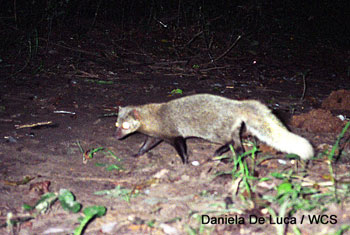Africa’s rarest carnivore spotted in Tanzania
Africa’s rarest carnivore spotted in Tanzania
mongabay.com
December 21, 2006
Africa’s rarest carnivore, Jackson’s mongoose, was spotted in the mountains of remote southern Tanzania by researchers with the Wildlife Conservation Society (WCS). Until now the species has been only known from a few observations and museum specimens.
The findings are reported in the latest issue of the journal Oryx.
The mongoose was recorded using a camera trap in in Matundu Forest within the Udzungwa Mountains National Park, a region that has recently yielded a number of species previously unknown to science.
 Daniela DeLuca/Wildlife Conservation Society |
Due to the rarity of the species WCS has recommended an expansion of protected ares in the region.
“Given the fragmentation and small sizes of the forest patches in which they live, full protection of nearby forests would improve conditions for conserving this species.” said Dr. Daniela De Luca, the WCS scientist who along with Dr. Francesco Rovero from Italy’s Trento Museum of Natural Sciences, discovered the species in Tanzania.
Tanzania is Africa’s most biodiverse country and its mountainous areas are still yielding unrecorded species. In 2004, WCS researchers working in the Southern Highlands of Tanzania discovered a new species of primate—the kipunji monkey—which in 2006 was described as an entirely new new genus of monkey. It was later found that the kipunji is also present in the Udzungwa Mountains.
Little is known about Jackson’s mongoose, which has “round, broad ears, with yellow fur on the neck and throat, and a white bushy tail” according to WCS.
Related articles
Conserving wildlife in Tanzania, Africa’s most biodiverse country. With ecosystems ranging from Lake Tanganyika to Mt. Kilimanjaro, Tanzania is the most biodiverse country in Africa. Though Tanzania is world famous for its safari animals, the country is also home to two major biodiversity hotspots: the Eastern Arc Mountains and the Albertine Rift surrounding Lake Tanganyika. Tanzania has set aside nearly a quarter of its land mass in a network of protected areas and more than one-sixth of the country’s income is derived from tourism, much of which comes from nature-oriented travel. Despite these conservation achievements, Tanzania’s wildlands and biodiversity are not safe. Fueled by surging population growth and poverty, subsistence agriculture, fuelwood collection, and timber extraction have fragmented and degraded extensive areas that are nominally protected. Hunting and unsustainable use of forest products have further imperiled ecosystems and species. In the near future, climate change looms as a major threat not only to Mt. Kilimanjaro’s glaciers, which are expected to disappear within ten years, but also to Tanzania’s many endemic plants and animals found in its montane forests
Anti-poaching patrols paying off for safari wildlife in Tanzania. Enforcement patrols are effectively cutting poaching of elephants, African buffaloes and black rhinos in the Serengeti National Park in Tanzania according to new research published in the journal Science.
Previously undiscovered species found in Tanzania. The first field surveys of the Rubeho Mountains in Tanzania revealed over 160 animal species–including a new species of frog and eleven endemic species–according to an article published in the African Journal of Ecology this month. The findings elevate the importance of protecting this biologically-rich wilderness area and the broader Eastern Arc Mountain range from destructive activities underway such as clear-cutting for agriculture, logging and poaching.
New monkey is most unique since swamp monkey in 1923. A new monkey species discovered last year by scientists with the New York-based Wildlife Conservation Society (WCS) and other groups is now shown to be so unique, it requires a new genus â” the first one for monkeys in 83 years, according to a study published in this week’s Science. But conservationists warn that quick action is needed to protect the monkey’s high-altitude forest home from illegal logging and hunting, or the species may soon vanish.
Toad on brink of extinction, scientists race to study amphibian for bioactive compounds. Under the bright florescent lights of the reptile house in the Bronx Zoo of New York, a colorful exotic toad makes its final stand. Once gathering by the thousands at the waterfalls of the Kihansi Gorge of Tanzania, the population of the Kihansi Spray Toad now stands at less than 200 individuals. The hasty construction of a desperately needed dam, built with good intentions by the World Bank, has relegated this species to the edge of existence.